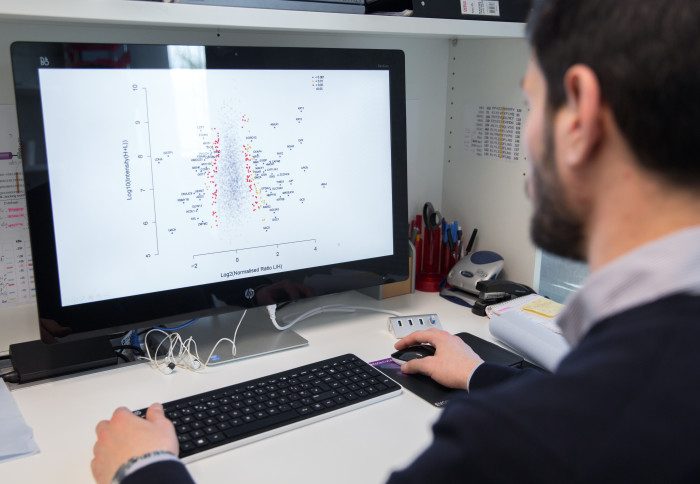Scientists discover mechanism controlling spread of pancreatic cancer

Scientists have shown it is possible to reverse a key process that allows pancreatic cancer cells to grow and spread around the body.
"By better understanding what drives the aggressive spread of pancreatic cancer, we hope to now exploit this knowledge and identify ways to make pancreatic cancer less aggressive, and more treatable." Professor Axel Behrens Scientific Director, CRUK Convergence Science Centre
A new study led by Professor Axel Behrens, Scientific Director of the Cancer Research UK Convergence Science Centre, has shown that it is possible to reverse a key process that allows pancreatic cancer cells to grow and spread around the body.
The findings of the study, published in Nature, show that a protein called GREM1 is key to regulating the type of cells found in pancreatic cancer – and manipulating its levels can both fuel and reverse the ability of these cells to change into a more aggressive subtype.
Researchers from Cancer Research UK Convergence Science Centre, Imperial College London and The Institute of Cancer Research, studied pancreatic cancer with the gene that makes the GREM1 protein switched off in mice, and in pancreatic ‘mini-tumours', which are also known as organoids.
They found that switching off GREM1 caused the tumour cells to rapidly change shape and develop new properties that help them invade new tissues and migrate around the body. Within just 10 days, all the tumour cells changed their identity into a dangerous, invasive cell type.
Switching off the gene also made tumours in mice more likely to spread. The researchers studied a mouse model of pancreatic ductal adenocarcinoma (PDAC) – the most common and aggressive form of the disease. The results show that around 90 per cent of mice without functioning GREM1 developed tumours which had spread to their liver, compared to 15 per cent of mice where GREM1 was working normally.
Pancreatic cancer has the lowest survival rates of common cancers. Less than seven per cent of people will survive for five years or more. More than 10,000 people are diagnosed with pancreatic cancer in the UK each year, and more than 9,000 will die from it.
Speaking about the findings, Professor Axel Behrens said: “This is an important and fundamental discovery that opens up a new avenue for uncovering treatments for pancreatic cancer. We have shown that it is possible to reverse cell fate in pancreatic cancer in the lab – turning back the clock on aggressive tumours and switching them to a state that makes them easier to treat."
He adds: “By better understanding what drives the aggressive spread of pancreatic cancer, we hope to now exploit this knowledge and identify ways to make pancreatic cancer less aggressive, and more treatable.”
Crucially, the scientists, who were largely funded by The Institute of Cancer Research (ICR), showed that boosting GREM1 levels could reverse this process and cause invasive cell types to revert into a less dangerous form. Researchers hope, in the future, to use this knowledge to find ways to reverse more advanced pancreatic cancer into a less aggressive form, which is easier to treat.
The researchers, who work in the Breast Cancer Now Toby Robins Research Centre at the ICR, stress that the science is early stage, and significant amounts of research would be required to discover and develop treatments that change PDAC cell fates and make the tumour respond better to therapies. However, fundamental discoveries such as this are crucial in directing efforts to find new cancer drugs and treatments.
The researchers also discovered that another protein, called BMP2, is involved in regulating GREM1, and that these two proteins regulate the form PDAC cells ultimately take, according to a mathematical model first proposed by Alan Turing in 1952. These ‘Turing patterns’ are found in nature – from the patterns on the skin of the giant puffer fish to seashells – and strikingly the same sort of patterns are seen in the different types of cells found in pancreatic cancer. Further studies are needed to determine whether this model is also applicable in other forms of cancer.
Speaking about the results of the study and future work, Professor Kristian Helin, Chief Executive of The Institute of Cancer Research, London, said: “This new finding has broadened our understanding of the molecular basis of how pancreatic cancer gains the ability to grow and spread around the body. Although more work is required, this type of fundamental research is essential for developing concepts for new and more effective treatments for cancer.”
Linxiang Lan, Theodore Evan, Huafu Li, Aasia Hussain, E. Josue Ruiz, May Zaw Thin, Rute M. M. Ferreira, Hari Ps, Eva M. Riising, Yoh Zen, Jorge Almagro, Kevin W. Ng, Pablo Soro-Barrio, Jessica Nelson, Gabriela Koifman, Joana Carvalho, Emma L. Nye, Yulong He, Changhua Zhang, Anguraj Sadanandam, Axel Behrens. GREM1 is required to maintain cellular heterogeneity in pancreatic cancer. Nature, 2022; DOI: 10.1038/s41586-022-04888-7
Materials provided by the Institute of Cancer Research. Content edited for style and length.
Article text (excluding photos or graphics) © Imperial College London.
Photos and graphics subject to third party copyright used with permission or © Imperial College London.
Reporter
Dorcas Ishaya
Department of Surgery & Cancer